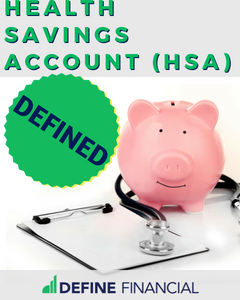
If you’re is looking for a way to be smarter with your money, you might want to think outside the box.
Sure, you should invest heavily for retirement and buy the right insurance products to protect your assets, but you probably already know that.
There is another unique strategy to consider. It’s a combination you may have never thought of – the Health Savings Account (HSA) and the High Deductible Health Plan (HDHP).
Health Savings Account (HSA) Defined
Did you know that you can use an HSA to save for retirement? This type of account isn’t just to pay for medical bills. It’s actually an investment account – and it’s awesome.
Side Note: An HSA is not the same thing as a Flexible Spending Account (FSA) or a Health Reimbursement Account (HRA).
There are three main reasons the HSA is so advantageous:
You get a get tax break when you put money into the account
If you are an individual, you can put $3,450 into an HSA for 2018. And, families can invest up to $6,850.
That’s a lot of money to invest. But, this investment will also lower your tax bill. It’s similar to when you put money into a traditional IRA account, traditional 401(k) account, or traditional 403(b) account. Money goes into the account, and your tax bill goes down that year.
There are no taxes when the money grows inside the account
Yes, you saved money on taxes by putting money into an HSA. But, that’s not the only advantage with an HSA. It gets better. If your investments pay out a dividend, there are no taxes if the dividend stays in the account. Just like with a 401(k) or Roth IRA, your money grows without the awful tax drag. You put the money in and it grows tax-free until you’re ready to take it out.
You don’t pay taxes when you take money out to pay medical bills
Believe it or not, things get even sweeter from here; you don’t pay taxes on HSA money when you make withdrawals to cover qualified medical expenses. This the holy grail of tax benefits! Being able to use your money tax-free on the back-end makes opening an HSA a no-brainer for most people.
But, before you run out to fund an HSA to give the IRS the shaft, know that there is a catch! You must use a High-Deductible Health Plan (HDHP) to put money into an HSA.
However, using an HDHP doesn’t have to be a bad thing. If you’re young and healthy, you probably want an HDHP regardless of whether you use an HSA or not. That’s because using an HDHP lets you use insurance the smart way: to protect us from the really big expenses, and not the small stuff that we can manage ourselves.
No Payroll Taxes When You Use Your Employer’s HSA
I said that there are three main reasons to use an HSA. But, there’s actually a fourth reason. However, not everyone qualifies for this fourth benefit: payroll tax savings.
When you contribute to the HSA provided by your employer – opting to have part of your paycheck put into your HSA via automatic payroll deductions – you get an extra tax benefit: you get to skip payroll taxes. For a family contribution ($6,900 for 2018), you can save more than $500 a year on payroll taxes. Whether the money comes out of the account for qualified medical expenses or not, you never have to pay these $500+ in taxes back. It’s a permanent tax savings.
Quadruple Tax-Advantaged
If you’re keeping score, there are at least three – if not four – tax advantages to using an HSA. That’s better than any other account. HSAs are magical unicorn investment accounts and should be fully-funded each year.
High-Deductible Health Plan (HDHP) Defined
A High-Deductible Health Plan is like a regular health insurance plan, but with a high deductible. The thing is, the requirements for what is considered a “high” deductible aren’t that outrageous.
According to the healthcare.gov, the IRS defines a High-Deductible Health Plan as any plan with a deductible of at least $1,350 for an individual or $2,700 for a family. On the other end of the equation, the total out-of-pocket expenses for the year must be limited to $6,650 for individuals, and $13,300 for families with these plans. Those expenses include deductibles, co-payments, and coinsurance.
In the real world, this means you may have to pay several thousand dollars in medical expenses before the insurance company starts chipping in. This is the deductible, which is the financial line in the sand that determines when the insurance company pays out benefits.
Having to pay several thousand dollars in unplanned medical bills before your own medical insurance starts paying those bills can get to be pretty expensive. So, why in the world would you want to put yourself in a situation? In the end, you have to take a look at the big picture.
First, you need to accept that you could end up paying more for a doctor’s visit with an HDHP than with plain-vanilla medical insurance. As an example, you may pay $200 for an unplanned doctor’s visit with an HDHP but only a $20 copay with a plain-vanilla health insurance plan.
But, just because you’re paying more for a single doctor’s visit doesn’t necessarily mean that you’re spending more money on your health. You have to consider your healthcare premiums, too. Consider this example:
High-Deductible Harry just paid a whopping $300 for an unscheduled doctor’s visit! Ouch! Remember, that $300 fee is in addition to High-Deductible Harry’s monthly insurance premiums: $100/month, or $1,200 for the year.
When you combine High-Deductible Harry’s monthly insurance premium plus the unscheduled doctor’s visit, High-Deductible Harry spent $1,500 on his health for the year. Now consider the alternative:
Plain-Vanilla Peter only spent $20 on his unscheduled doctor’s visit. That’s not bad at all. However, Plain-Vanilla Peter also has a monthly insurance cost of $200/month, or $2,400/year.
When you add the cost of Plain-Vanilla Peter’s medical expenses up for the year, he’s looking at $2,420.
| Patient | Monthly Insurance Premium | Annual Insurance Premium | Co-pay | Total Medical Expenses for 2018 |
| High-Dedctuble Harry | $100 | $1,200 | $300 | $1,500 |
| Plain-Vanilla Peter | $200 | $2,400 | $20 | $2,420 |
The numbers above are fake, but the point of the story is real. You can pay more for unscheduled doctor’s visits with an HDHP but still come out ahead provided you remain in good health.
Why an HSA & HDHP Makes Sense for Young Professionals
When you opt for an HDHP, you can come out ahead financially. This can be the case despite some unplanned medical bills. That’s because the cost of insurance is less expensive for an HDHP than with a plain-vanilla health plan. But that’s not the only reason.
Free Money
If you’re working for a company, you may be given the choice between an HDHP and a plain-vanilla health plan. In some cases, your employer may actually give you free money if you choose the HDHP. Usually, this means your employer will deposit cash into your Health Savings Account.
In the past, both my spouse and I have received several hundred dollars per year from our employers when we opted for the HDHP over a plain-vanilla health plan. So, even if you have to pay for an unscheduled doctor’s visit when using an HDHP, that money can come from your HSA.
Be Young & Healthy
Of course, having few unplanned doctor’s visits is the key to winning the finance game when you have an HDHP. On average, that means those who are relatively younger and healthier may want to think about using an HDHP.
The opposite is also true. If you’re dealing with ongoing health issues or you’re getting to an age where you are likely to have ongoing health issues, think about using a plain-vanilla health plan.
At the very least, run the numbers to see which option might be a better deal for the short-term.
How to Use a Health Savings Account
Let’s get back to the magical Health Savings Account (HSA). Yes, you can save money in the account and pull it out whenever your medical bill shows up. But, just because you can, doesn’t mean you should. At the end of the day, the HSA is best used for investing.
Why is the HSA so great for investing?
It all boils down to taxes. Having no taxes on your money as it grows is awesome because it lets your money to grow faster. But, when you take your money out to cover medical bills, you lose that tax benefit.
For that reason, you should keep money in your HSA for as long as possible. That may mean paying for unplanned medical bills out of your regular checking account. (This is why having a rainy day fund is so important!)
Of course, eventually, you are going to take money out of your HSA to pay for medical bills. But, give the Health Savings Account (HSA) a few decades to grow first. In the end, doing that means you’ll have more money.
Save Your Receipts for Medical Expenses to Take Out Tax-Free Money
With an HSA, you can take money out money – tax-free – for qualified medical expenses. But, you don’t have to take out money when you have expenses. Here’s how this works:
Planner Paul puts $6,900 into his Health Savings Account. Paul gets a tax deduction, and gets to save even more money on payroll taxes.
That same year, Paul has a $4,000 denist visit. Ouch! (Ouch because no one likes going to the dentist, and because no one likes spending $4,000 at the dentist! Sorry dentists!)
Planner Pual – being the planner that he is – decides not to take money from his Health Savings Account. (But, he saves the receipt for the $4,000.) Paul pays the dentist’s bill out of his rainy day fund. That leaves $6,900 in his Health Savings Account, continuing to grow.
Seven years later, that $6,900 is now $13,800. And in another seven years after that, Paul’s HSA balance is $27,600. That’s when Paul decides to retire. Without a job, Paul needs to tap his investment accounts to pay for living expenses. And he does. Paul dips into his Health Savings Account – now worth $27,600 – to pull out $4,000 tax-free!
Paul pulls $4,000 from his HSA tax-free because he had a qualifying medical expense. Therefore, if you can afford to pay for your medical expenses out of pocket and save your receipts, you can get some tax-free money in the future!
How to Use a High-Deductible Health Plan
If you were paying attention, you’ll notice in the examples above that High-Deductible Harry had to pay extra money because his doctor’s visit was unplanned. Had High-Deductible Harry planned his visit, he may have been able to pay less over all. Here are some tips for lowering your costs when using a High-Deductible Health Plan.
Opt for Preventative Care
Get a flu shot. Sign up for birth control. Have that annual physical. In an HDHP, preventative care is free. So, take advantage of it. Not only will you be getting health care at no cost, but you may prevent having to see the doctor in the future.
Get the Timing Right
Are you expecting some injuries from your newest hobby, fire dancing? In that case, you may want to skip the HDHP altogether.
Know Thyself
Are you the type of person who runs to the doctor when something seems out of order? Or, are you more likely to wait it out to see if it gets better with time? If the former, an HDHP may not make the most financial sense for you. That’s because the costs of unscheduled doctor’s visits can add up.
Health Savings Account to Invest Like a Champ
If you’re young and healthy and you have control of your spending, think about combining the HDHP with the HSA. Doing so will allow you to:
- Save money on health care
- Possibly score some free money from your employer
- Enjoy a tax break for putting money into your HSA
- Let your investments grow without the burden of taxes
When it comes to saving money, this healthcare combination is one you can’t afford to ignore. We all need to save money on taxes where we can, and tax-free growth is the bomb. If you never consider combining the HSA with the HDHP, you will miss out.
Disclaimer: This article is for entertainment purposes only. None of this is to be considered tax advice. Before doing anything, speak with a qualified tax professional.


